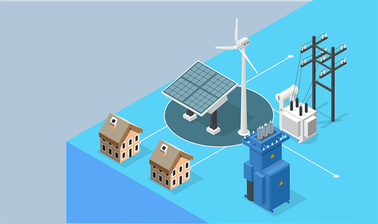- Level Awareness
- Ratings
- المدة 20 hours
- الطبع بواسطة Imperial College London
- Total students 2,512 enrolled
-
Offered by

عن
Wind turbines and solar panels are likely to play a critical role in achieving a low-carbon power sector that helps address climate change and local pollution, resulting from fossil fuel power generation. Because wind and solar power output is weather-dependent, it is variable in nature and somewhat more uncertain than output from conventional fossil fuel generators. It is therefore important to consider how to manage high penetrations of solar and wind so as to maintain electricity system reliability.
This introductory course, delivered by Ieading academics from Imperial College London, with technical input and contributions from the National Energy Renewable Lab (Golden, Colorado), will discuss what challenges variable output renewables pose to the achievability of a reliable, stable electricity system, how these challenges can be addressed and at what costs. Its overall objective is to demonstrate that there is already a range of established technologies, policies and operating procedures to achieve a flexible, stable, reliable electricity system with a high penetration of renewables such as wind and solar.
The course uses a variety of country and context-specific examples to demonstrate the concepts. Policy makers, regulators, grid operators and investors in renewable electricity will benefit from a solid understanding of these considerations, thereby helping them drive forward the development of a fit-for-purpose clean power system in their own regional context.
What you will learn
- Explain how electricity systems have traditionally operated with baseload and load-following conventional generators
- Introduce and explain the basic operational characteristics of the main types of electricity generation technologies, including fossil fuel, nuclear and renewables
- Describe how electricity system operations change when there are increasing penetrations of variable renewables
- Discuss the technologies, measures and operating practices at our disposal to cost-effectively incorporate and manage high penetrations of variable renewables
- Consider how the operation of electricity systems may change in the future, with changes in electricity demand patterns and the emergence of new technologies
- Understandhow different countries are managing the integration of variable renewables into their electricity systems.
Skills you learn
Syllabus
- How do electricity systems work? An introduction
- How do different types of electricity generation technology work?
- How are electricity systems affected by increased penetrations of variable renewables?
- Options for managing increased penetrations of variable renewables
- What might the future hold?
- Policies and incentives to overcome barriers
Auto Summary
"Join this engaging course, 'Incorporating Renewable Energy in Electricity Grids,' focusing on managing high penetrations of wind and solar power to maintain system reliability. Delivered by Imperial College London experts with insights from the National Energy Renewable Lab, this 20-hour course covers technologies, policies, and procedures essential for a stable, renewable-based power system. Ideal for policymakers, regulators, grid operators, and investors, it offers professional-level awareness and practical examples to drive clean energy advancements."

Ajay Gambhir


